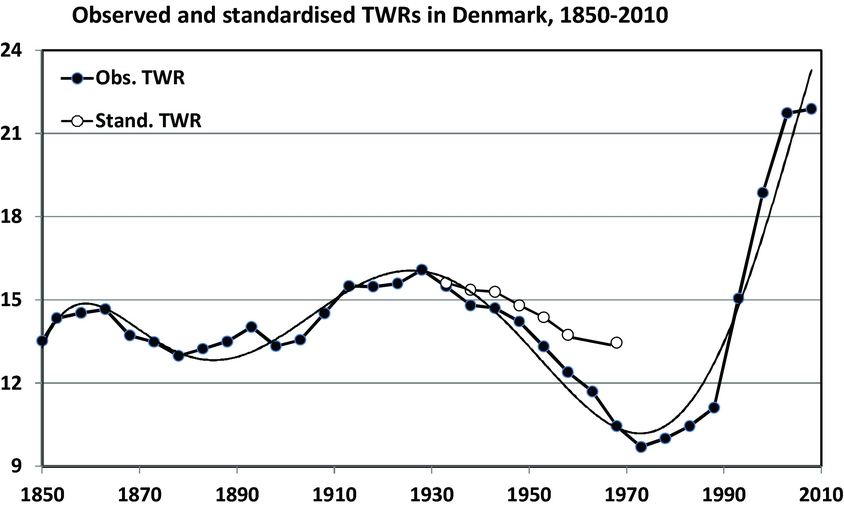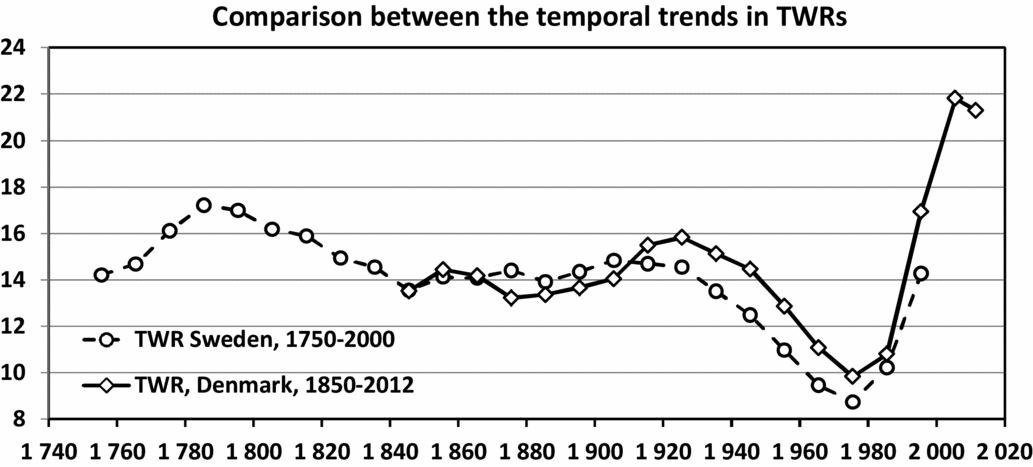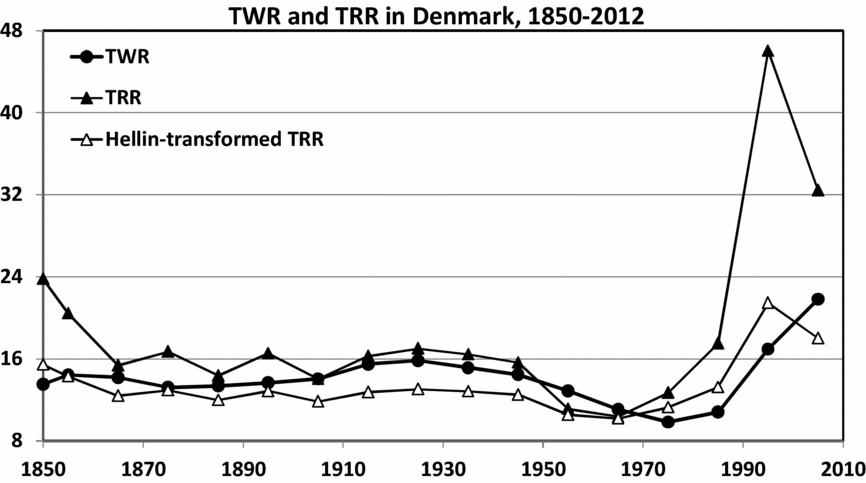To elucidate the causes of twinning and higher multiple maternities, Fellman and Eriksson (Reference Fellman and Eriksson2014) studied birth registers from Sweden, 1751–2000. Strong temporal fluctuations in the rates of multiple maternities were observed, corresponding with earlier studies (Eriksson & Fellman, Reference Eriksson and Fellman2004; Eriksson et al., Reference Eriksson, Fellman and Lundström1996; Fellman & Eriksson, Reference Fellman and Eriksson1993). Maternal age and parity could not satisfactorily explain the temporal differences in the TWR, that is, the number of twin maternities per 1,000 maternities. Consequently, the noted fluctuations must be influenced by other factors. Fellman and Eriksson (Reference Fellman and Eriksson2014) stressed that a more urban and comfortable lifestyle, reflected also in the diet and accompanied by increased stress and sedentary occupations, may have reduced the physical capacity of the mothers to carry gestations with multiple fetuses to completion. These factors may be the most influential ones. The temporal differences in the TWRs in Denmark obtained in this study were similar to the results presented by Fellman and Eriksson (Reference Fellman and Eriksson2014). Findings from other European countries are discussed.
Materials and Methods
In this study, two sets of data were analyzed. The first were birth data for Denmark from 1850 to 2012. The data were obtained from Statbank Denmark (2014). This data set gives the temporal trends for singleton, twin, triplet, and quadruplet deliveries for the period 1850–2012. The second set yields the TWRs for the period 1931–1967. These data were introduced by Professor Eriksson during his professorship at the Free University of Amsterdam. His group ordered this special data set from Statbank Denmark. The period is short, but the data set contains information about maternal age, parity, and age-specific TWRs. This information enabled Fellman and Eriksson (Reference Fellman and Eriksson1990) to perform standardization of the TWR for the period 1931–1967. The data was also used to obtain secular and regional differences in the seasonal variations in TWR in Denmark (Eriksson & Fellman, Reference Eriksson and Fellman1999).
Results
Figure 1 shows the observed TWR in Denmark for the period 1850–2012. One observes strong temporal fluctuations. Modeling these is difficult. The figure follows Fellman and Eriksson (Reference Fellman and Eriksson2014) in that it includes a trend line, but to obtain a good fit the line must be a sixth-degree polynomial. This temporal trend line yields a good fit (R 2 = 0.9321), but it cannot explain the fluctuations. For the period 1931–1967, a standardization was implemented. During the period 1931–1967 the rate decreases markedly. The standardization was performed to obtain a comparison with the situation in 1931–1935 as the norm. The standardization has reduced the decline, but a marked decrease remains. Note that the observed TWR for 1961–1967 is 11.69 per 1,000. After the standardization, the TWR for this period is 13.45. Consequently, the effect of the standardization is only 1.76. The standardization could reduce, but not eliminate, the deep trough. During the period 1931–1967 the difference between the standardized and observed TWRs shows an increasing trend. These findings support the statement given by Fellman and Eriksson (Reference Fellman and Eriksson2014) and observed above that standardization according to maternal age (and parity) cannot explain the fluctuations. Possible influential factors are explored in the Discussion section.

FIGURE 1 Temporal trends in the twinning rates (TWR) in 1850–2012, and the standardized TWR in 1931–1967 in Denmark. The temporal trendline is a sixth-degree polynomial with good fit (R 2 = 0.9321).
In Fellman and Eriksson (Reference Fellman and Eriksson2014), an analogous study of the temporal trends of TWR in Sweden was performed. Despite the different periods investigated, Figure 2 shows similar fluctuations in Denmark and Sweden.

FIGURE 2 Comparison between the temporal trends in twinning rates (TWR) in Denmark (1850–2012) and Sweden (1750–2000), given in Fellman and Eriksson (Reference Fellman and Eriksson2014). Note the similar pattern in the series.
Figure 3 presents the TWR, the observed triplet rate (TRR) per 100,000, and the Hellin-transformed TRR per 1,000 for the period 1850–2012. The transformation of the TRR according to Hellin's law was performed in order to compare the TRR and the TWR on the same scale. The extreme minima are obtained for the TRR in the 1960s and for the TWR in the 1970s. After the extreme minima for TRR and TWR, steep increases in the rates are observed. The increases are mainly caused by the introduction of ovulation inducers and other assisted artificial reproduction techniques (ART). Before the minima, the transformed TRR curve is situated below the TWR curve, but after the minima the order is the opposite, indicating that the ART had a relatively stronger influence on the occurrence of triplet than twin maternities. However, when the Hellin transformation is performed, the effect of the ART yields comparable increases in TWR and the Hellin-transformed TRR.

FIGURE 3 Temporal trends in the twinning rate per 1,000 (TWR), the triplet rate per 100,000 (TRR) and the Hellin-transformed TRR per 1,000 for 1850–2012 (see text for details).
Discussion
Fellman and Eriksson (Reference Fellman and Eriksson2014) evaluated the effect of changing socio-economic factors on the rates of multiple deliveries. The increased urbanization and industrialization that started in Sweden in the last decades of the 19th century disbanded the static agrarian isolates and caused Sweden, within two to three generations, to develop from a poor nation into one of the most prosperous in the world. In Denmark, a similar urbanization started in the second half of the 19th century. The influence of urbanization on the multiple maternities noted for Sweden by Fellman and Eriksson (Reference Fellman and Eriksson2014) is also seen in Denmark. The increases in the rates of multiple maternities after the 1970s in both Denmark and Sweden were mainly caused by the introduction of ovulation inducers and other ART. Therefore, in our opinion, only the series before the launch of ART starting in the 1960s can be used for studies of the frequencies of multiple maternities (Fellman & Eriksson, Reference Fellman and Eriksson2014).
In a long series of studies, the socioeconomic effects on the TWR in different European countries were investigated and comparable results were obtained. The effect of privation on the TWR was compared between Scandinavia, Germany, and the Netherlands (Eriksson et al., Reference Eriksson, Bressers, Kostense, Pitkänen, Mielke, Jorde and Tas1988). The temporal trends in the TWR were investigated in England and Wales (Eriksson & Fellman, Reference Eriksson and Fellman2007; James Reference James1980; Smith et al., Reference Smith, Manktelow, Draper, Boyle, Johnson and Field2014). Similar studies of the TWRs were performed in France (Pison & Couvert, Reference Pison and Couvert2004), in Spain (Fuster et al., Reference Fuster, Zuluaga, Colantonio and de Blas2008; 2010), and in Hungary (Pári, Reference Pári2014).
Acknowledgments
Dedicated to the memory of my good friend and colleague for over 50 years, Professor Aldur W. Eriksson, well known for his twin research. This study was supported by grants from the Magnus Ehrnrooth Foundation.




